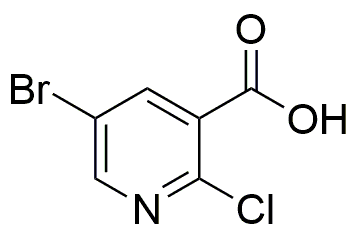5-Bromo-2-chloronicotinic acid is widely utilized in research focused on:
- Pharmaceutical Development: This compound serves as a key intermediate in the synthesis of various pharmaceuticals, particularly those targeting neurological disorders. Its unique halogen substitutions enhance biological activity.
- Agricultural Chemistry: It is used in the formulation of agrochemicals, including herbicides and fungicides, providing effective solutions for crop protection while minimizing environmental impact.
- Material Science: The compound is employed in the development of advanced materials, such as polymers and coatings, due to its ability to modify surface properties and improve durability.
- Biochemical Research: Researchers utilize this chemical in studies related to enzyme inhibition and receptor binding, aiding in the understanding of various biochemical pathways.
- Organic Synthesis: It acts as a versatile building block in organic synthesis, allowing chemists to create complex molecules with precision and efficiency, often leading to more sustainable processes compared to traditional methods.
General Information
Properties
Safety and Regulations
Applications
5-Bromo-2-chloronicotinic acid is widely utilized in research focused on:
- Pharmaceutical Development: This compound serves as a key intermediate in the synthesis of various pharmaceuticals, particularly those targeting neurological disorders. Its unique halogen substitutions enhance biological activity.
- Agricultural Chemistry: It is used in the formulation of agrochemicals, including herbicides and fungicides, providing effective solutions for crop protection while minimizing environmental impact.
- Material Science: The compound is employed in the development of advanced materials, such as polymers and coatings, due to its ability to modify surface properties and improve durability.
- Biochemical Research: Researchers utilize this chemical in studies related to enzyme inhibition and receptor binding, aiding in the understanding of various biochemical pathways.
- Organic Synthesis: It acts as a versatile building block in organic synthesis, allowing chemists to create complex molecules with precision and efficiency, often leading to more sustainable processes compared to traditional methods.
Documents
Safety Data Sheets (SDS)
The SDS provides comprehensive safety information on handling, storage, and disposal of the product.
Product Specification (PS)
The PS provides a comprehensive breakdown of the product’s properties, including chemical composition, physical state, purity, and storage requirements. It also details acceptable quality ranges and the product's intended applications.
Certificates of Analysis (COA)
Search for Certificates of Analysis (COA) by entering the products Lot Number. Lot and Batch Numbers can be found on a product’s label following the words ‘Lot’ or ‘Batch’.
Numéro de catalogue
Numéro de lot/série
Certificates Of Origin (COO)
This COO confirms the country where the product was manufactured, and also details the materials and components used in it and whether it is derived from natural, synthetic, or other specific sources. This certificate may be required for customs, trade, and regulatory compliance.
Numéro de catalogue
Numéro de lot/série
Safety Data Sheets (SDS)
The SDS provides comprehensive safety information on handling, storage, and disposal of the product.
DownloadProduct Specification (PS)
The PS provides a comprehensive breakdown of the product’s properties, including chemical composition, physical state, purity, and storage requirements. It also details acceptable quality ranges and the product's intended applications.
DownloadCertificates of Analysis (COA)
Search for Certificates of Analysis (COA) by entering the products Lot Number. Lot and Batch Numbers can be found on a product’s label following the words ‘Lot’ or ‘Batch’.
Numéro de catalogue
Numéro de lot/série
Certificates Of Origin (COO)
This COO confirms the country where the product was manufactured, and also details the materials and components used in it and whether it is derived from natural, synthetic, or other specific sources. This certificate may be required for customs, trade, and regulatory compliance.


